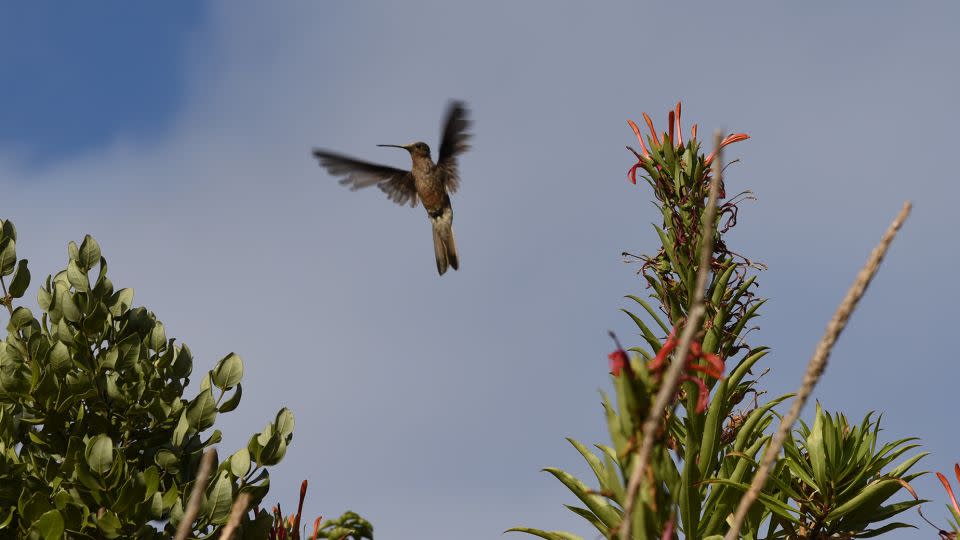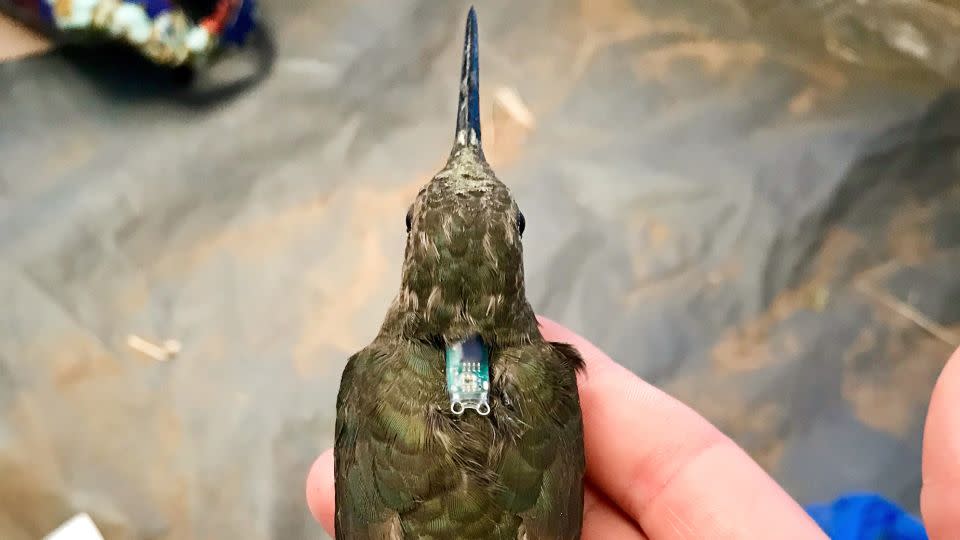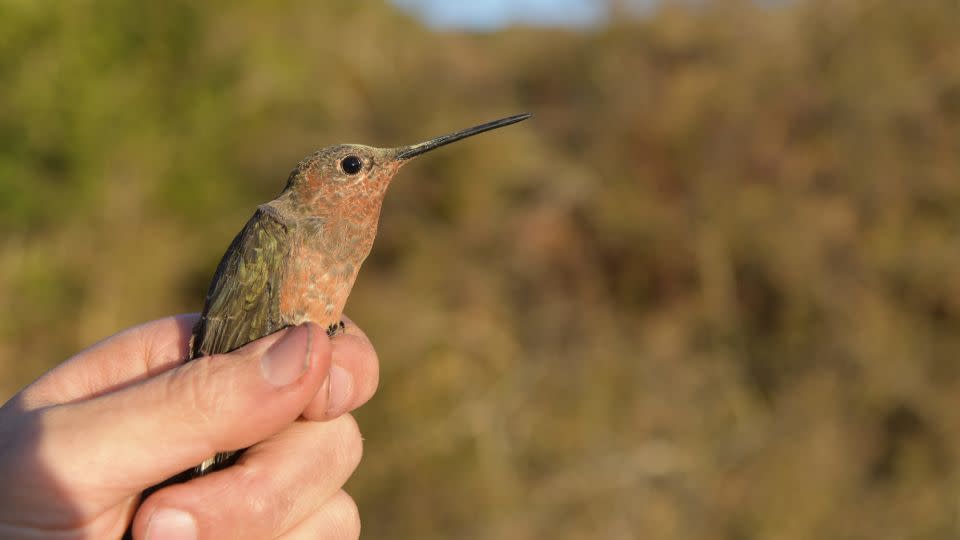Sign up for CNN’s Wonder Theory science newsletter. Explore the universe with news about fascinating discoveries, scientific developments and more.
The world’s largest hummingbird has been hiding in plain sight for centuries — and scientists only discovered that the species is distinct from another giant species after strapping small backpacks to hummingbirds to understand migration patterns.
Along the way, researchers also identified the longest hummingbird migration journey, covering a round trip of 8,368 kilometers, or about the distance between New York City and Buenos Aires.
Questions surrounding South America’s giant hummingbird have persisted since naturalist Charles Darwin first observed them in 1834 during his expedition aboard HMS Beagle.
Darwin observed the birds, which are about eight times the size of typical hummingbirds, as they breed along Chile’s Pacific coast, but then they appeared to disappear completely after breeding. He speculated that the giant hummingbirds migrated to the Atacama Desert region, located in northern Chile.
Now new research has shown that two different species of giant hummingbirds live in South America – the northern giant hummingbird that lives year-round in the Andes, and the migratory southern giant hummingbird – and that they have been developing separately for millions of years.

A new study describing the birds appeared Monday in the journal Proceedings of the National Academy of Sciences.
“There aren’t many animal migrations of large, charismatic species that are still completely unknown, but that was the case for southern giant hummingbirds,” said lead study author Jessie Williamson, a National Science Foundation Postdoctoral Fellow and Rose Postdoctoral Fellow at the Cornell Laboratory of Ornithology in Ithaca , New York. “We wanted to finally solve this mystery.”
Designing backpacks for hummingbirds
Giant hummingbirds differ from hundreds of other hummingbird species in many other ways.
“Everything about the giants is abnormal – not only are they much larger (twice or more) than the next largest hummingbird – but their wingbeats and heartbeats are much slower,” said Williamson. “And their wings are proportionately longer, giving them a completely unique appearance in flight – almost like a gliding swift.”
Swifts are medium-sized fast-flying birds belonging to the family Apodidae, which also includes hummingbirds.
But studying hummingbirds, regardless of their size, is an arduous task. The team worked with local landowners and residents of villages in Peru and Chile during fieldwork.
“Catching giant hummingbirds is quite a challenge,” said co-author Emil Bautista, a researcher at the Centro de Ornitología y Biodiversidad in Lima, in a statement. “They keep an eye on everything and know their territory well. We had to be strategic when choosing locations for our nets. If giant hummingbirds see something unusual, they will not visit that place. They are more observant than other birds.”
The research team spent nine months camping in rural parts of Chile and Peru, working from sea level to the steep, cactus-strewn slopes of the Andes and going without electricity or running water for weeks, Williamson said.
Williamson designed a backpack harness, using a type of jewelry cord to attach a microtracking device to 57 hummingbirds in Chile.
“Designing suitable backpack harnesses for giant hummingbirds took two seasons of trial and error, including practicing the harness design on a stuffed hummingbird finger puppet…with a mock papier-mâché geolocator, plus considerable consultation with colleagues experienced in tracking small migratory birds,” said Williamson.


The geolocator backpacks weighed 0.3 grams and were designed to be small and light enough so that they did not interfere with the birds’ flying style.
Williamson published a paper describing her design and how to safely attach it to hummingbirds in June 2021 in the Journal of Avian Biology.
“Hummingbirds are challenging to work with because they are lightweight and have long wings and short legs. They are nature’s little acrobats,” she said.
But it wasn’t enough to catch the birds, strap on the backpacks and release them; the birds had to be captured again before the team could collect the data.
The researchers were able to retrieve data from eight of the geolocators by recapturing the birds using fine-mesh nets called “mist nets” often used by ornithologists, Williamson said.
What the team discovered was that migrating southern giant hummingbirds are like human mountain climbers.
Bird flights at high altitude
The geolocator data showed that migrating giant hummingbirds can ascend from sea level to more than 13,000 feet (3,962 meters) in altitude, and their journeys took them as far north as the Peruvian Andes.
But the birds don’t just fly straight to these towering heights. Instead, like mountain climbers, they pause for days during their ascent to allow their blood and lungs to acclimatize to the lower oxygen levels.
By tracking the birds’ migration with geolocators and satellite transmitters, the scientists discovered what they believe is the longest known hummingbird migration, stretching 8,368 kilometers from the Chilean coast to the Andes in Peru and back.
As the researchers studied the birds and compared them to genetic data from museum specimens, they realized that there were two types of giant hummingbirds.
“No one had discovered where migrating giant hummingbirds go because they were hiding among the non-migrating giant hummingbirds,” said senior study author Christopher Witt, professor of biology and director of the Museum of Southwestern Biology at the University of New Mexico, in a statement . “The two forms of giant hummingbirds look virtually identical – for centuries ornithologists and bird watchers never noticed they were different. We couldn’t have come up with this without the miniaturized trackers.”
A change in migration behavior likely caused the difference between the two species. By studying museum specimens, including a 154-year-old specimen, the researchers realized that the two species of giant hummingbirds had been evolving separately for about 3 million years.
“They are as different from each other as chimpanzees and bonobos,” Witt said. “The two species overlap on their high-altitude wintering grounds. It is baffling that no one has yet discovered the mystery of the Giant Hummingbird, when these two species have been separated for millions of years.”
The northern giant hummingbird, which lives year-round in the high Andes, has a different lung and blood capacity than the southern giant hummingbird.
After realizing that the two birds were completely different species, the research team named the northern giant hummingbird Patagona chaski, a nod to chaskis, the Quecha word for messengers, of the Inca empire. Quecha is a group of indigenous languages used in Peru and neighboring countries.
“Chaski runners were steady sprinters, capable of speed and endurance on steep slopes, thanks in part to high-capacity lungs and rigorous aerobic training at high altitude,” the authors wrote in the study.
New bird mysteries arise
The researchers reported that both populations of giant hummingbirds are stable, and some can even be seen enjoying nectar from backyard feeders.


Now that the two different species have been confirmed, the team wants to better understand how the populations interact, especially if they live in the same parts of the Andes during winter.
“We need to figure out where these two shapes meet and how they interact,” Witt said. “Do they compete, is one dominant over the other, how can they partition resources, and do they mix or separate spatially within the winter range? There are many interesting questions to get started with!”
Williamson also wants to work with botanists to understand how the birds’ migration patterns may have co-evolved with the flowering plants the birds use for sustenance during their travels.
“I’m very interested in how southern giant hummingbirds make such dramatic elevation changes during migration,” said Williamson. “They’re like miniature mountain climbers. How do they change their physiology to facilitate these movements?”
For more CNN news and newsletters, create an account at CNN.com